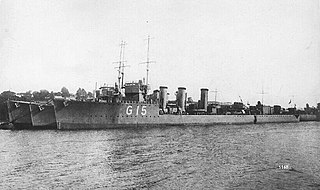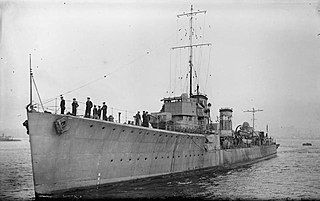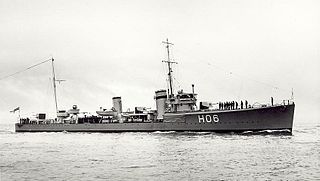
HMS Romola was an R-class destroyer which served with the Royal Navy during World War I. Launched on 14 May 1916, the ship operated as part of the Grand Fleet, operating as part of a destroyer flotilla. The ship sailed to intercept the German High Seas Fleet in what would be one of the last major expeditions of their Navy in the war but saw no action. After the conflict, the destroyer was held in reserve until being retired and sold to be broken up on 13 March 1930.

HMS Tourmaline was an S-class destroyer, which served with the Royal Navy during the Greco-Turkish War and the Russian Civil War. Tourmaline was one of three destroyers ordered from Thornycroft in June 1917 with more powerful geared turbines than the majority of the class as well as design changes that improved seakeeping. Launched on 19 April 1919, the vessel operated as part of the Fourth Destroyer Flotilla serving with the Atlantic and Mediterranean Fleets. After serving in the Black Sea and Sea of Marmara, during which sister ships Speedy and Tobago were lost, Tourmaline led the Gibraltar Local Defence Flotilla. The London Naval Treaty, signed 1930, required the retirement of some destroyers to meet the Royal Navy's tonnage requirement and Tourmaline was chosen for retirement. The destroyer was decommissioned on 28 November 1931 after 12 years of service and broken up.

HMS Sturdy was an S-class destroyer, which served with the Royal Navy. Launched in 1919, the destroyer visited the Free City of Danzig the following year but then spent most of the next decade in the Reserve Fleet. After a brief period of service in Ireland in 1931, Sturdy was divested of armament in 1934 and equipped with a single davit to rescue ditched aircraft, and acted as plane guard to the aircraft carrier Courageous. The ship subsequently took part in the 1935 Naval Review. Re-armed as a minelayer, the destroyer was recommissioned the following year and reactivated at the start of the Second World War. Sturdy was then employed escorting convoys in the Atlantic Ocean, but ran aground off the coast off the Inner Hebrides island at Tiree in 1940. The vessel was split in two by the waves. The crew evacuated, apart from three sailors who died, and the destroyer was lost.

HMS Tribune was an S-class destroyer that served with the Royal Navy during the Russian Civil War. Launched in 1918, the vessel entered service with the Aegean Squadron of the Mediterranean Fleet. Tribune saw no action during the First World War but was involved in supporting the evacuation of refugees from the Russian Civil War, particularly from Crimea in 1920 and 1921. The ship also visited Constantinople in 1920 and 1922 during the Turkish War of Independence. In 1923, the destroyer was transferred to the Atlantic Fleet. In 1929, the ship took part in simulated amphibious warfare with the Territorial Army. In 1930, the signing of the London Naval Treaty required the Royal Navy to retire older destroyers before acquiring new ones. Tribune was one of those chosen for retirement and, in 1931, the destroyer was sold to be broken up.

HMS Trinidad was an S-class destroyer that served with the Royal Navy. The ship was named after the island in the West Indies. Launched on 8 May 1918, the vessel entered service with the Grand Fleet but saw no action during the during the First World War. After the Armistice, Trinidad joined the Mediterranean Fleet. War had broken out between Greece and Turkey and there was intelligence that the Soviet Union was selling warships to one of the belligerents. Trinidad was part of a small flotilla that was sent to investigate and, ultimately, halt this trade. However, it turned out to be a hoax. The destroyer subsequently returned to Constantinople. In 1930, the signing of the London Naval Treaty required the Royal Navy to retire older destroyers before acquiring new ones. Trinidad was one of those chosen for retirement and, on 16 February 1932, the destroyer was sold to be broken up.

HMS Sepoy was an S-class destroyer, which served with the Royal Navy during the First World War and the Russian Civil War. Sepoy was launched in 1918 and initially joined the Grand Fleet. After the Armistice that ended the First World War, the ship was briefly transferred to the Reserve Fleet before sailing to Tallinn in 1919 as part of the Royal Navy response to the fighting there. Sepoy rejoined the Reserve Fleet at the end of the year. In 1922, the destroyer served in the Mediterranean Sea. The ship was later allocated to the naval base in Hong Kong, arriving in 1929. During exercises the following year, a depth charge explosion killed six sailors. The destroyer was also damaged. Following the signing of the London Naval Treaty a few days later, Sepoy returned to the United Kingdom and, in 1932, was sold to be broken up at Newport, Wales.

HMS Senator was an S-class destroyer, which served with the Royal Navy during the First World War, Greco-Turkish War and Russian Civil War. The S class were a development of the previous R class, and Senator was the first of six constructed by Denny. Senator was launched on 2 April 1918 and joined the Mediterranean Fleet. After the Armistice that ended the First World War, the destroyer continued to serve in active duty, both in the Mediterranean and the Black Seas. For example, in 1919, the ship helped cover the evacuation of Russian troops from Batumi. In 1925, Senator was placed in reserve and, in 1936, was given to Thos. W. Ward of Sheffield in part-exchange for the liner RMS Majestic.

HMS Seraph was an S-class destroyer, which served with the Royal Navy during the Russian Civil War. The S class were a development of the previous R class, with minor differences, constructed at the end of the First World War. Seraph had a career as an evacuation vessel more than as a warship. Launched in 1918 by Denny, Seraph was originally destined for the Grand Fleet but, after the Armistice, the destroyer transferred to the Mediterranean Fleet based at Malta. The destroyer was sent into the Black Sea to support the White Russian forces in their fight against the Communists. The role involved supporting the movement of troops rather than firing at the enemy. Ultimately, the Communists won and Seraph helped the evacuation of White Russian troops from Crimea, returning to Malta in 1921. The destroyer was then stationed in the Eastern Mediterranean in 1923 in response to the tensions in Turkey. In 1927, the ship was sent to Hong Kong to serve under the Commander-in-Chief, China. In 1929, the vessel was once again called to evacuate, this time Christian missionaries from the Chinese Red Army. Once again, the evacuation took place without bloodshed. With the introduction of more modern destroyers, the Royal Navy started retiring the S class and, in 1934, Seraph was sold to be broken up.

HMS Sesame was an S-class destroyer, which served with the Royal Navy in the twentieth century. Launched on 30 November 1918 just after the end of the First World War, the ship was commissioned into the Reserve Fleet. A year later, the destroyer was sent to Latvia in support of the country's call for independence, arriving just at the cessation of that county's war of independence. Returning to the United Kingdom, Sesame was later equipped to act as a plane guard within the Home Fleet, with all armament removed and a davit fitted to rescue aircraft. The vessel remained in that configuration for a short time, but the London Naval Treaty sounded the death knell for the ship as it limited the destroyer tonnage that the Royal Navy could operate. As newer and more powerful destroyers entered service, Sesame was one of those retired, being sold to be broken up on 4 May 1934.

HMS Northesk was an Admiralty M-class destroyer which served in the Royal Navy during the First World War. The M class was an improvement on the previous L-class destroyer, capable of higher speed. The vessel was launched in 1916 and joined the Grand Fleet. Northesk was involved in escorting convoys, including the first southbound convoy on the coastal route between Lerwick andImmingham in 1917. After the Armistice that marked the end of the First World War, the destroyer joined the Mediterranean Fleet and operated in the area around Sevastopol, including assisting in the evacuation of the Crimea in 1919. Soon afterwards, in 1921, Northesk was decommissioned and sold to be broken up.

HMS Shamrock was an S-class destroyer, which served with the Royal Navy in the twentieth century. Launched on 26 August 1918 just before the end of the First World War, the ship was commissioned into the Home Fleet. A year later, the destroyer was sent to the Baltic Sea during the Russian Civil War to support Latvia, arriving just at the cessation of that country's war of independence. The vessel was later sent to join the Local Defence Flotilla at Gibraltar. It was while serving there that the destroyer escorted the first Prime Minister of Republican Spain, Niceto Alcalá-Zamora, on an official visit to Spanish Morocco and helped evacuate civilians from Malaga at the start of the Spanish Civil War. Shamrock was retired soon after and sold to be broken up on 23 November 1936.

HMS Hope was the first warship constructed by Swan Hunter and one of 20 Acorn class destroyers built for the Royal Navy that served in the First World War. The Acorn class were smaller than the preceding Beagle class but oil-fired and better armed. Launched in 1910, Hope served with the Second Destroyer Flotilla of the Grand Fleet as an escort based at Devonport for most of the war, protecting ships like RMS Aquitania, until being transferred to Malta to serve with the Fifth Destroyer Flotilla as part of the Mediterranean Fleet in 1917. Hope collided with and sank the destroyer HMS Arno in 1918. After the Armistice, the destroyer continued to serve in Malta under being sold in 1920.

HMS Lyra was one of 20 Acorn class destroyers built for the Royal Navy that served in the First World War. The Acorn class were smaller than the preceding Beagle class but oil-fired and better armed. Launched in 1910, Lyra was part of the winning side in war games that took place the following year, although the destroyer sustained damage due to fast running. At the start of the war, the ship served with the Second Destroyer Flotilla of the Grand Fleet, and spent most of the war in anti-submarine warfare, mainly protecting merchant ships from attack. Despite being involved in many actions, the destroyer did not sink any enemy boats. Lyra ended the war in Gibraltar. After the Armistice, the destroyer was placed in reserve before being sold to be broken up in 1921.

HMS Sheldrake was one of 20 Acorn-class destroyers built for the Royal Navy. The destroyer served in the First World War. The Acorn class were smaller than the preceding Beagle class but oil-fired and better armed. Launched in 1910, Sheldrake served with the Second Destroyer Flotilla of the Grand Fleet as an escort, transferring to Malta to serve with the Fifth Destroyer Flotilla as part of the Mediterranean Fleet in 1916. The ship once again served as an escort, protecting ships from submarines and mines, including the troopship Ivernia, as well as unsuccessfully attempting to rescue the sloop Nasturtium. After the Armistice, the destroyer was reduced to reserve before being sold to be broken up in 1921.

HMS Redpole was one of 20 Acorn-class destroyers built for the Royal Navy that served in the First World War. The Acorn class were smaller than the preceding Beagle class but oil-fired and better armed. Launched in 1910, the ship served with the Second Destroyer Flotilla, joining the Grand Fleet at the start of the war, and was transferred to the Mediterranean Fleet in 1915, joining the Fifth Destroyer Flotilla. Employed as an escort, the ship also undertook other duties, including rescuing the Italian destroyer Benedetto Cairoli in 1918. Redpole ended the war in Gibraltar. After the Armistice, the destroyer was placed in reserve before being sold to be broken up in 1921.

HMS Scotsman was an S-class destroyer that served with the Royal Navy during the Russian Civil War. The S class was a development of the previous R class, with minor differences, constructed at the end of the First World War. Scotsman was completed in May 1918 and joined the Grand Fleet for the last few months of the War. The destroyer then joined the British campaign in the Baltic, sailing as part of a detachment of ten destroyers under the command of Admiral Walter Cowan in March 1919. Scotsman provided military and humanitarian assistance to the Latvian cities of Liepāja and Ventspils in April 1919. On returning to the UK, the ship was placed in reserve, initially at Rosyth and later Devonport. The destroyer remained in reserve until, in July 1937, Scotsman was sold in part-exchange for the liner Majestic and broken up.

HMS Seabear was an S-class destroyer that served with the Royal Navy during the Russian Civil War. The S class was a development of the previous R class, with minor differences, constructed at the end of the First World War. Seabear was launched in December 1917 and joined the Grand Fleet for the last few months of the War. The destroyer then joined the British campaign in the Baltic, sailing as part of a detachment of ten destroyers under the command of Admiral Walter Cowan in March 1919. Seabear sailed to Tallinn in support of the Estonian War of Independence the following month. On returning to the UK, the ship was placed in reserve. The London Naval Treaty limited to number of destroyers that the Royal Navy could operate and, as new ships entered service, older vessels were retired. Seabear was sold in February 1931 and broken up.

HMS Scout was an S-class destroyer that served with the Royal Navy from the end of the First World War to the end of the Second World War. On retirement, the vessel was the oldest destroyer in the Royal Navy. The S class was a development of the previous R class, with minor differences, constructed as a cheaper and faster alternative to the V and W class. Launched in 1918, Scout joined the Grand Fleet for the last few months of the First World War before sailing in 1919 under the command of Rear-admiral Walter Cowan to participate in the British campaign in the Baltic. Scout was part of a flotilla attacked by four Russian destroyers, led by Avtroil, but sustained no damage and, on returning to the UK, was placed in reserve. The vessel participated in coastal artillery training exercises near the River Tees in 1934 and ran aground in 1938 but returned to service in the China Station before the start of the Second World War. Scout assisted in the defence of northern Sumatra after the United Kingdom declaration of war on Japan and evacuated naval personnel from Singapore after the fall of the island before being transferred to Trincomalee, Ceylon, in 1942, serving as an escort for the remainder of the war. With peace, Scout was retired and, in 1946, sold to be broken up.

HMS Seawolf was an S-class destroyer that served with the Royal Navy and, in 1922, was commanded by the future Admiral of the Fleet, John Tovey. Launched in 1918 just before the end of the First World War, the warship initially joined the torpedo school at Devonport before, in 1919, serving briefly in the Latvian War of Independence. Subsequently deployed to Ireland, the vessel carried some of the bodies of the victims of Bloody Sunday to their funerals in 1920 and, in 1924, rescued the passengers and crew of the steamship Asian that had sunk in a storm near Queenstown. After the London Naval Treaty of 1930 restricted the tonnage of destroyers operated by the Navy, Seawolf was retired and, in 1931, was sold to be broken up.

HMS Nereide was one of 20 Acorn-class destroyers built for the Royal Navy. The destroyer served in the First World War. The Acorn class were smaller than the preceding Beagle class but oil-fired and better armed. Launched in 1910, Nereide served with the Second Destroyer Flotilla based at the naval base at Devonport until being transferred to the Mediterranean Fleet in 1917. The vessel was employed primarily in an anti-submarine role, undertaking escort and patrol duties. In 1918, the destroyer participated in the bombardment of Durazzo. After the Armistice, the destroyer was reduced to reserve before being sold to be broken up in 1921.
















